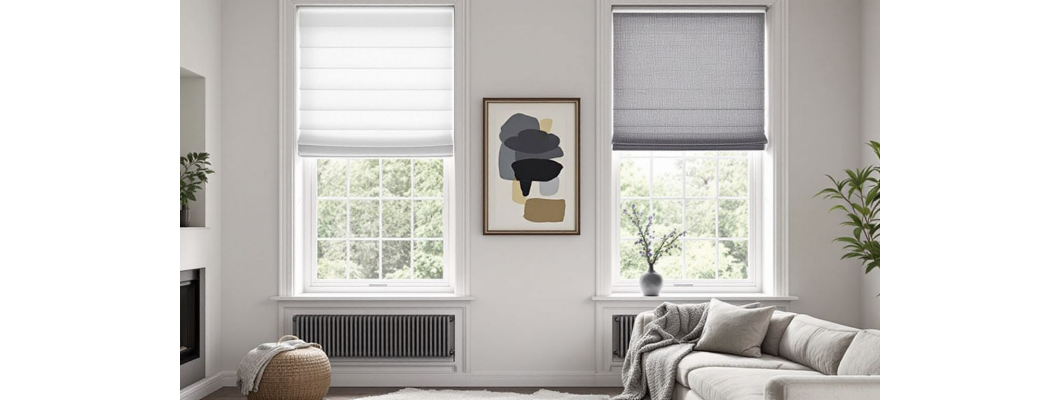
When it comes to Roman blinds vs roller blinds, many homeowners wonder which is the better choice. In this article, we’ll break down the styles, functions, and costs of each to help you decide.
Key Takeaways
Roman blinds feature a classic pleated design and provide excellent insulation, making them ideal for traditional decor and energy efficiency.
Roller blinds offer a modern, streamlined look and are easy to maintain, making them suitable for contemporary settings and moisture-prone areas.
Key differences include style preferences, functionality for light control, and cost considerations, with Roman blinds generally being pricier and requiring more maintenance than roller blinds.
Understanding Roman Blinds and Roller Blinds
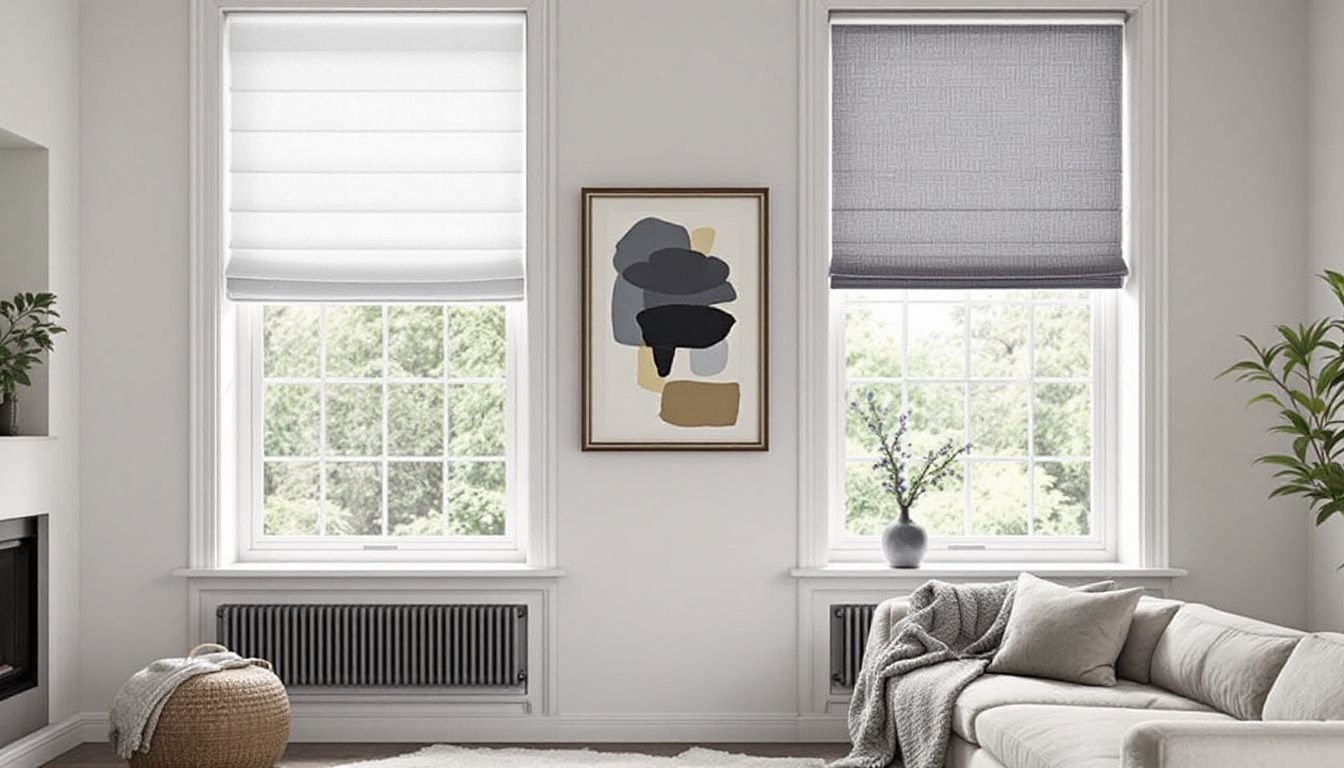
Roman blinds and roller blinds serve the same essential purpose of covering windows, but they differ significantly in style, finish, and functionality. These two types of blinds are integral to interior design, each offering unique features that cater to different tastes and needs.
This guide aims to help you choose between Roman and roller blinds by providing a comprehensive comparison of their characteristics and applications.
What Are Roman Blinds?
Roman blinds are known for their classic pleated design, which allows them to create a sumptuous window dressing that lets in very little light when closed. They are more decorative than roller blinds, contributing to a classic style that enhances the aesthetic appeal of any room. Available in various materials, including silk, linen, and cotton, Roman blinds offer a wide range of customisation options to suit different interior decor styles. Bespoke Roman blinds often come with a metal headrail and removable brackets for easy fitting and adjustment.
These blinds are commonly used in living areas to create a warm and inviting ambience. Selecting fabrics that complement the room’s decor allows Roman blinds to enhance the overall aesthetic. They can also feature light-filtering, thermal, or blackout Roman blind linings to improve their functionality in various settings, making them a versatile choice for any home.
What Are Roller Blinds?
Before: Roller blinds consist of a single piece of fabric that rolls around a tube, ensuring a streamlined and modern look. Common materials for roller blinds include vinyl and PVC, which are known for their durability and ease of maintenance. Laminated roller blinds are available in various styles, such as blackout, laminated, and duo, catering to different needs and preferences. Duo roller blinds, for example, create a sleek design that resembles Venetian blinds while offering dynamic light-shading options.
After: Roller blinds consist of:
A single piece of fabric that rolls around a tube, ensuring a streamlined and modern look
Common materials such as vinyl and PVC are known for their durability and ease of maintenance
Various styles, including blackout, laminated, and duo, cater to different needs and preferences
Duo roller blinds, for example, create a sleek design that resembles Venetian blinds while offering dynamic light-shading options.
These blinds suit various spaces, including homes, offices, and commercial areas. Waterproof roller blinds, in particular, are a practical choice for kitchens and bathrooms due to their resistance to moisture.
Roller blinds provide a modern appearance that can enhance various interior styles, making them a popular choice for contemporary decor.
Key Differences Between Roman and Roller Blinds
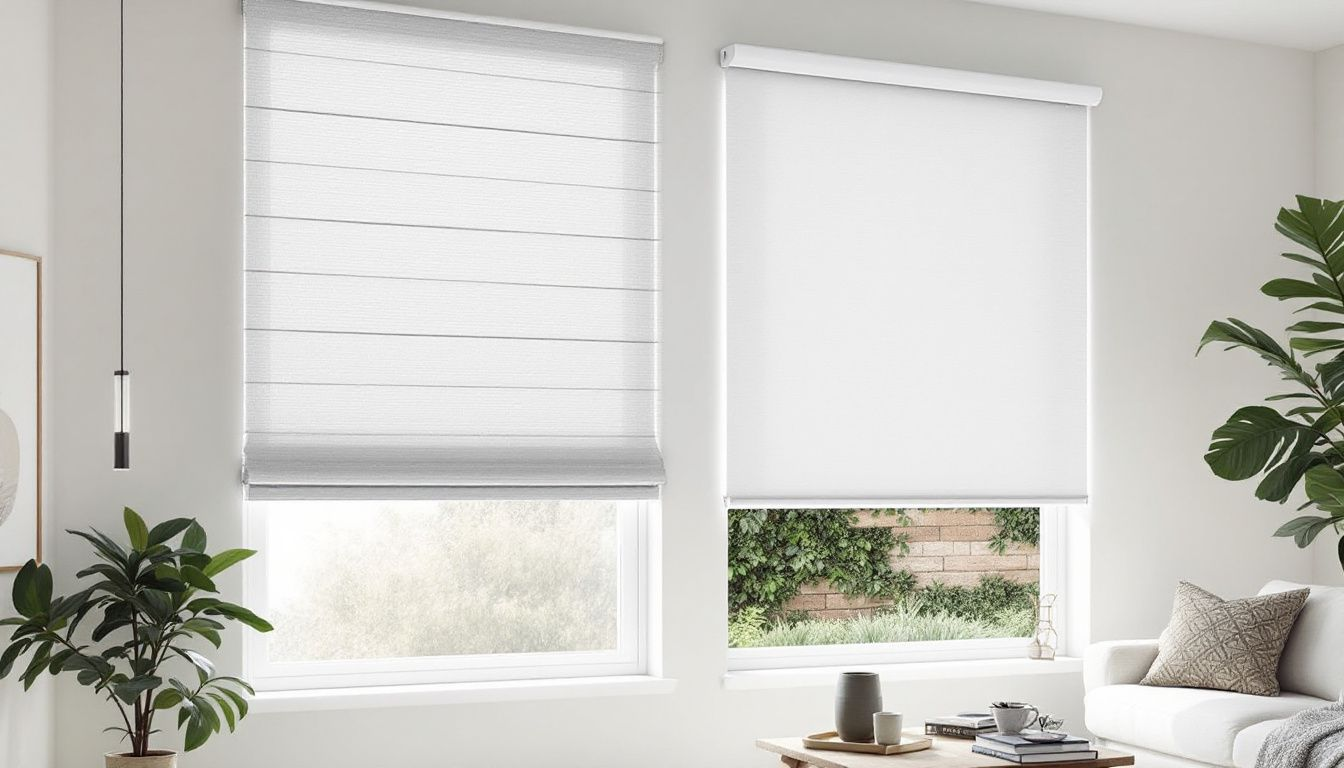
Knowing the key differences between Roman and roller blinds helps in selecting the best window treatment for your home. These differences encompass style and aesthetics, functionality and practicality, and cost considerations, each of which plays a significant role in determining which type of blind is right for you.
Style and Aesthetics
Roman blinds lend themselves to a classic interior style, while roller blinds are often considered more modern in terms of style and aesthetics. Roller or Roman blinds offer a luxurious appearance with various fabric options, making them a more sumptuous window dressing choice for those who prefer a traditional look.
In contrast, roller blinds are celebrated for their sleek and simple design, which suits contemporary interior decor. Pairing Roman blinds with roller blinds can add depth and enhance the overall decor of a living room.
Functionality and Practicality
The primary distinction between Roman and roller blinds lies in their operating mechanisms; roller blinds roll up while Roman blinds fold. This difference affects their light control capabilities, with blackout roller blinds being particularly effective at blocking light, making them ideal for bedrooms and areas where darkness is a priority. When considering options, it’s essential to weigh Roman blinds vs roller.
Roman blinds, depending on their lining, may let in more light, which can limit their light control compared to roller blinds. The thermal lining in Roman blinds enhances insulation, minimising heat loss in winter and keeping rooms cool in summer, which is crucial for energy efficiency and demonstrates the blind's thermal properties.
Cost Considerations
Roman blinds are generally pricier due to their complex designs and luxurious materials. The intricate design and quality materials result in a higher initial purchase cost compared to roller blinds.
However, long-term maintenance expenses may vary. Roman blinds may need more upkeep, affecting the overall cost over time. This factor is important to consider when budgeting for your window treatments.
Pros and Cons of Roman Blinds
Roman blinds offer various benefits and drawbacks to consider when choosing the right window treatment for your home. These include their aesthetic appeal, insulation properties, and maintenance requirements.
Benefits of Roman Blinds
One of the main benefits of Roman blinds is their excellent insulation. The layered fabric design traps air, providing superior thermal retention and keeping rooms warm in winter. This makes Roman blinds ideal for draughty and cold rooms, enhancing energy efficiency. Additionally, the fabric used in Roman blinds can create a cosy and luxurious ambience, adding to their decorative appeal.
Roman blinds are often favoured for their classic and tailored look, which complements traditional interior designs. Custom-made Roman blinds provide a perfect fit for windows, improving both insulation and privacy.
Drawbacks of Roman Blinds
Despite their benefits, Roman blinds also have some drawbacks. They generally come with a higher cost compared to roller shades due to their intricate designs and luxurious materials. Regular maintenance is needed to keep them looking their best, as the fabric folds attract dust and dirt, requiring frequent cleaning.
Moreover, Roman blinds may not be as durable in moisture-prone areas, such as kitchens or bathrooms, where humidity can affect their longevity. The fabric used in Roman blinds can also fade with prolonged exposure to sunlight, which is another factor to consider.
Pros and Cons of Roller Blinds
Roller blinds tend to offer several advantages and disadvantages that should be considered when selecting the right window blind treatment for your home.
These include their affordability, ease of maintenance, and insulation properties.
Benefits of Roller Blinds
The affordability of roller blinds makes them a budget-friendly option for window treatments. Roller blinds are also known for their ease of maintenance, as they can be easily wiped down or occasionally washed with a soft sponge and mild detergent. This makes roller blinds an ideal choice for busy households where convenience is a priority.
Roller blinds offer a sleek, modern appearance, perfect for minimalist and contemporary spaces. Their streamlined design enhances the overall look of a room, adding elegance without overwhelming the decor.
Drawbacks of Roller Blinds
Roller blinds also have some drawbacks. They are less effective in insulation compared to Roman blinds, primarily due to their sleek, single-layer design. This can make them less suitable for rooms where temperature regulation is a priority.
Additionally, roller blinds can be noisy, which may be a drawback for some users. While they can be cheaper than other options, this affordability may come at the cost of a cheaper-looking or thinner appearance, which may not suit every decor style.
Choosing the Right Blinds for Different Rooms
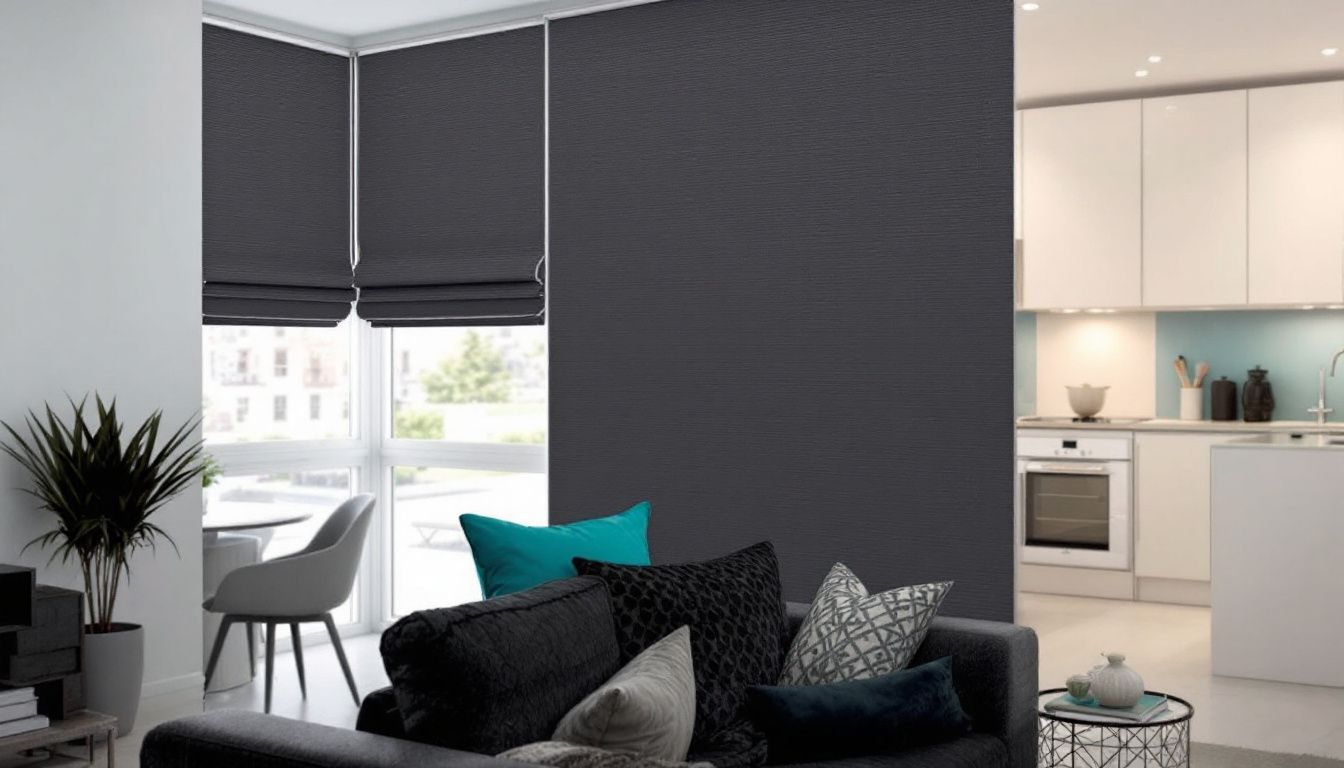
Selecting the right blinds for different rooms is crucial to achieving the desired balance of privacy, light control, and style. Each room has unique requirements, and the right choice can enhance both functionality and aesthetic appeal.
Best Blinds for Bedrooms
Effective light control is key for creating a restful environment in bedrooms. Blackout blinds roller blinds provide complete light control, making them ideal for bedrooms and areas requiring privacy. These blinds can effectively block out light, ensuring a dark and peaceful sleeping environment.
Roman blinds are recommended for a softer, cosier feel in bedrooms. Layering Roman shades with curtains adds depth and texture to the bedroom decor, creating a warm and inviting atmosphere.
Best Blinds for Kitchens and Bathrooms
Kitchens and bathrooms require window treatments that are resistant to moisture and easy to clean. Roller blinds are particularly suited for these areas due to their easy maintenance and availability in waterproof materials. Waterproof roller blinds are practical, ensuring longevity and functionality in moisture-prone environments.
Roman blinds, however, may not be the best choice for kitchens and bathrooms. Their fabric construction and lack of waterproof qualities make them less suitable for high-moisture areas. Choosing materials that withstand humidity and are easy to clean ensures your blinds remain in good condition for longer.
Best Blinds for Living Rooms
Living rooms benefit from blinds that balance privacy, light control, and style. Roman blinds are typically used in living areas to create a warm and inviting atmosphere. They offer a luxurious appearance and are beneficial for reducing sunlight exposure while adding a touch of elegance to both small and large windows.
Roller blinds add colour and personality to living rooms with various patterns and textures. Their versatility allows them to match different interior design themes, making them a flexible choice for any living space.
Decorative accessories like tassels or tiebacks can further enhance the appearance of both Roman and roller blinds, making your living room stylish and comfortable.
Customisation Options for Roman and Roller Blinds
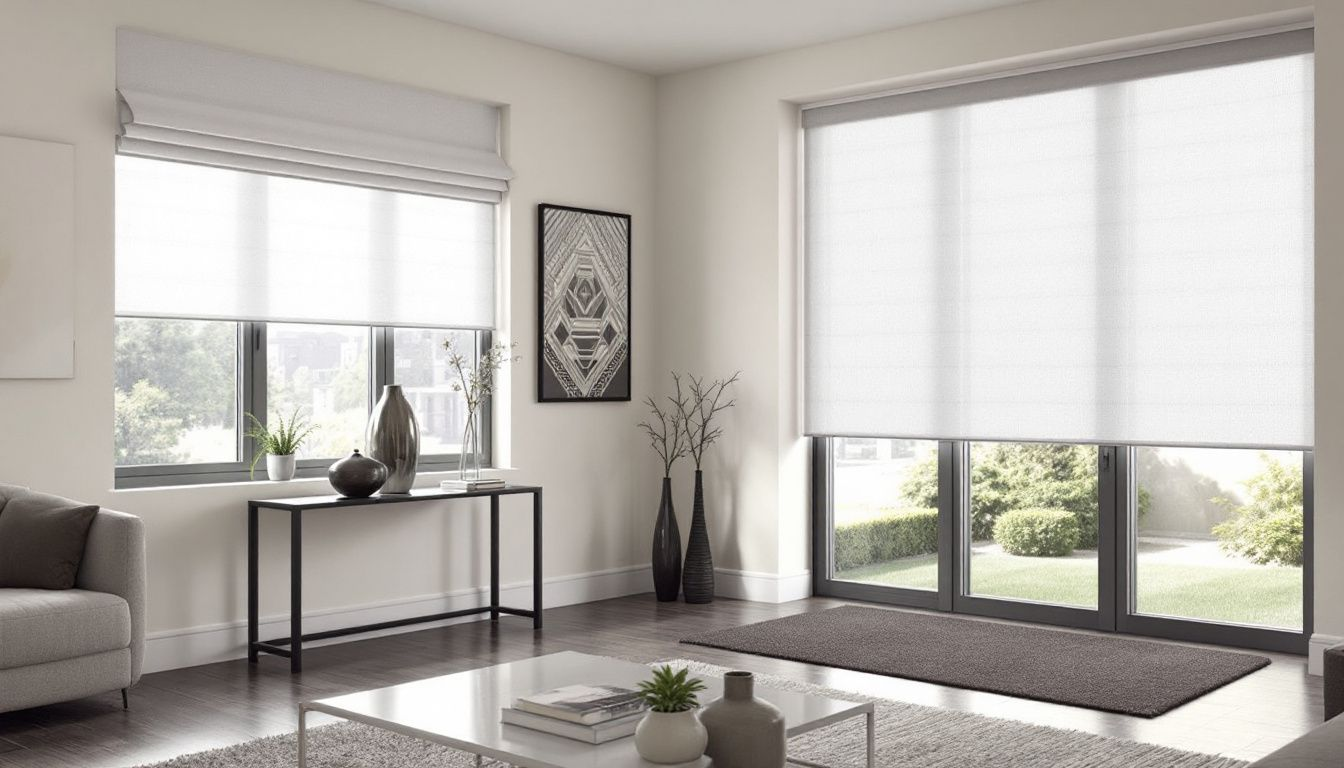
Customisation options for Roman and roller blinds allow you to tailor your window treatments to fit your personal style and functional needs. From fabric choices and colours to additional features and accessories, there are numerous ways to make your blinds unique and perfectly suited to your home.
Fabric Choices and Colours
Roman blinds are available in a variety of fabrics, including luxurious materials like velvet and heavyweight fabrics in rich colours such as Prussian Blue and Mulberry. These fabric choices provide a sumptuous window dressing that can complement both traditional and modern home designs. Choosing the right fabric enhances the thermal properties of the blinds and ensures they match your interior decor.
Roller blinds also come in a wide array of styles, materials, and colours. Whether you prefer a minimalist look or a bold pattern, a roller blind option can fit your aesthetic. The variety of fabric choices available for both Roman and roller blinds allows for personalised interior design that reflects your taste and enhances the overall decor of your home.
Additional Features and Accessories
Additional features such as blackout lining greatly enhance the functionality of your blinds, especially in bedrooms where light control and privacy are essential. Blackout linings help block out light and improve insulation, contributing to a comfortable sleeping environment.
Modern roller blinds can be integrated into smart home systems, allowing for remote operation and added convenience. This smart functionality ensures that you can control your blinds effortlessly, enhancing privacy and energy efficiency.
With options for different trimmings and the ability to add shields for mechanisms, both Roman and roller blinds can be customised to meet your specific needs and preferences.
Maintenance Tips for Roman and Roller Blinds
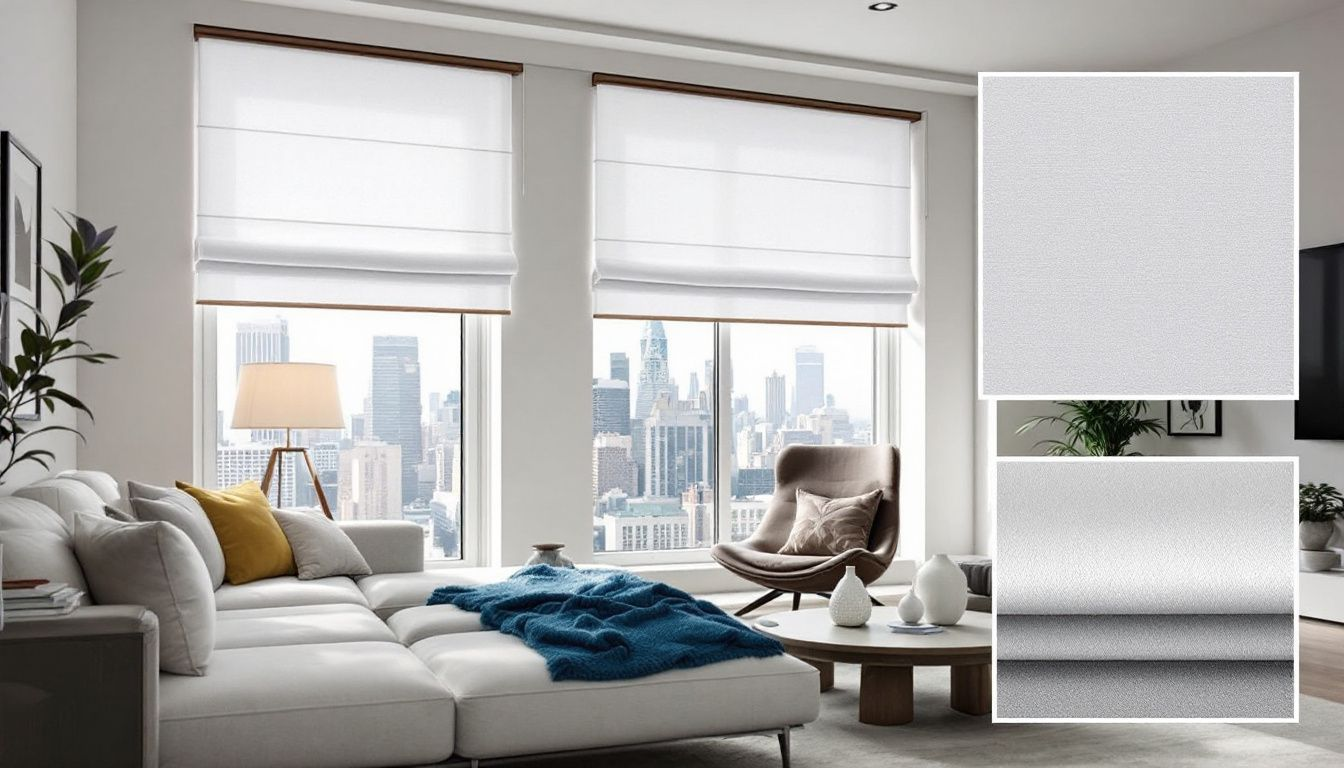
Maintaining your blinds ensures their longevity and keeps them looking their best. Roman and roller blinds have different maintenance requirements, and understanding these can help you keep your window treatments in top condition.
Cleaning Roman Blinds
Roman blinds typically require more care and often need professional cleaning due to the fabric’s sensitivity to stains. Using a vacuum with a brush attachment is effective for removing dust from Roman blinds without damaging the fabric. For a thorough cleaning, Roman blinds may need to be taken down, depending on the fabric and the level of cleaning required.
Given their fabric construction, Roman blinds can be susceptible to stains, which necessitates careful maintenance. Regularly vacuuming and spot cleaning can help maintain their appearance and prolong their lifespan.
Cleaning Roller Blinds
Roller blinds are known for their low-maintenance nature, making them an ideal choice for busy households. Cleaning roller blinds is straightforward; most can be wiped down with a soft sponge and mild detergent without needing to remove them from their brackets. This makes maintaining roller blinds convenient and hassle-free.
For spot cleaning, a damp cloth is often sufficient to remove stains, ensuring that your roller blinds remain clean and presentable with minimal effort. Their ease of maintenance is one of the key benefits that make roller blinds a popular choice for many homeowners.
Summary
Both Roman and roller blinds offer unique benefits and drawbacks that cater to different needs and preferences. Roman blinds provide a luxurious and classic style with excellent insulation properties, making them ideal for traditional decor and energy efficiency. On the other hand, roller blinds offer a sleek, modern look with easy maintenance and affordability, suitable for contemporary spaces. By understanding the key differences and considering the specific requirements of each room, you can make an informed decision that enhances both the functionality and aesthetic appeal of your home. Choose wisely, and let your blinds transform your living space into a beautiful and comfortable haven.
Frequently Asked Questions
Are Roman or Roller Blinds Better?
The choice between Roman and roller blinds depends on your personal style preferences and the functional needs of your space. Roman blinds offer a classic, elegant look with excellent insulation, making them ideal for traditional decor and energy efficiency. Roller blinds, on the other hand, provide a sleek, modern appearance and are easier to maintain, which suits contemporary interiors and moisture-prone areas like kitchens and bathrooms.
What Are the Disadvantages of Roman Blinds?
Roman blinds, while aesthetically pleasing, can be more expensive due to their intricate designs and luxurious materials. They often require more maintenance, as the fabric folds can accumulate dust and dirt. Additionally, Roman blinds are less suitable for high-moisture areas, as their fabric construction can be affected by humidity.
Which Is Better, Roman Shades or Roller Shades?
Roman shades are better suited for those seeking a classic, sophisticated look with added insulation for energy efficiency. Roller shades are ideal for individuals who prefer a minimalist, modern style with low maintenance requirements. The decision ultimately depends on your decor style and the specific needs of your room.
Do Roman Blinds Make a Room Look Bigger?
Roman blinds can make a room appear larger by drawing the eye upwards with their elegant folds, creating the illusion of height. Choosing lighter colours and materials can enhance this effect, making the space feel more open and airy.
